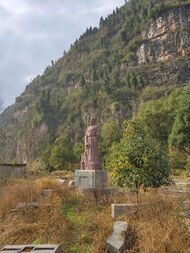Yuhuangdong Grottoes
Topic: Earth
 From HandWiki - Reading time: 2 min
From HandWiki - Reading time: 2 min
Short description: Taoist stone sculptures on Makong Mountain, Hunan Province, China
 | |
| Location | Zhangjiajie, China [1] |
|---|---|
| History | |
| Builder | Li Jingkai[2] |
| Founded | 1807[3] |
| Cultures | Taoism |
Yuhuangdong Grottoes[4] (Chinese: 玉皇洞石窟), or Yuhuang Grottoes,[5] named after the statue of the Jade Emperor carved inside the cave,[6] are Chinese Taoist stone sculptures,[7] located on a cliff at the southern foot of Makong Mountain (麻空山),[8] Fengxianggang Township (枫香岗乡), Yongding District, Zhangjiajie City, Hunan Province.[9]
Distribution
Yuhuangdong Grottoes, 10 kilometers away from the urban area,[10] are distributed on a section of precipice about 300 meters long from east to west and more than 130 meters high.[11]
History
Yuhuangdong Grottoes were excavated by Li Jingkai (李京开), a Qing Dynasty Yongding country gentry (乡绅),[12] and In 1799, these grottoes began to be constructed in 1799 and it took eight years to complete in 1807.[13]
References
- ↑ People's Republic of China Dictionary, Volume 5. Commercial Press. 1998. ISBN 978-7-100-03254-4. https://books.google.com/books?id=9NAQAQAAMAAJ.
- ↑ "Members of Zhangjiajie Yongding Branch of Jiu San Society visited Yuhuangdong Grottoes". Jiusan Society. Oct 26, 2020. http://www.hn93.gov.cn/mobile/detail/9340.
- ↑ Yi Xiaochun (2003). Hunan. China Light Industry Press. pp. 156–. ISBN 978-7-5019-3938-1. https://books.google.com/books?id=NGkLAQAAMAAJ.
- ↑ Ni Hao. Travel Guide of Hunan. DeepLogic. pp. 75–. https://books.google.com/books?id=2tGJDwAAQBAJ&pg=PT75.
- ↑ Wang, Kai; Gan, Chang; Ou, Yan; Liu, Haolong (4 July 2019). "Low-Carbon Behaviour Performance of Scenic Spotsin a World Heritage Site". Sustainability 11 (13): 3673. doi:10.3390/su11133673.
- ↑ China Self-Help Tour (6th ed.). China Light Industry Press. 1 January 2012. pp. 1303–. ISBN 978-7-5019-8528-9. https://books.google.com/books?id=dKfSDwAAQBAJ&pg=PT1303.
- ↑ Mou Zhongjian (1991). Daoism: A Concise Treatise on Taoism. Qilu Publishing House. p. 697. ISBN 978-7-5333-0214-6. https://books.google.com/books?id=fXoyAAAAMAAJ.
- ↑ Sanxiang Resort Tour. Hunan Fine Arts Publishing House. 1981. pp. 62–. https://books.google.com/books?id=CClNAAAAMAAJ.
- ↑ Hunan Cultural Heritage Atlas. Yuelu Publishing House. 2008. p. 291. ISBN 978-7-80761-040-3. https://books.google.com/books?id=9VELAQAAMAAJ.
- ↑ "Zhangjiajie actually has a grotto through the Qing Dynasty". Ifeng.com. 2019-11-27. https://news.ifeng.com/c/7rwTscwV9jO.
- ↑ Wan Li (1 June 2011). Huxiang Cultural Dictionary (8). Hunan People's Publishing House. pp. 112–. ISBN 978-7-999008-97-2. https://books.google.com/books?id=oWJ6DwAAQBAJ&pg=PT112.
- ↑ Jiao Chenggen; Chen Jian (1 September 2010). Huxiang Stone Sculptures. Hunan Fine Arts Publishing House. pp. 313–. ISBN 978-7-5356-3812-0. https://books.google.com/books?id=N11qDwAAQBAJ&pg=PT313.
- ↑ Two Thousand Years of Zhangjiajie. Wuzhou Communication Press. 2005. pp. 55–. ISBN 978-7-5085-0618-0. https://books.google.com/books?id=FWDmFMrGe84C&pg=PA55.
 |
Licensed under CC BY-SA 3.0 | Source: https://handwiki.org/wiki/Earth:Yuhuangdong_Grottoes10 views | Status: cached on October 05 2024 23:18:29↧ Download this article as ZWI file
 KSF
KSF